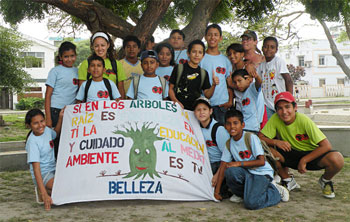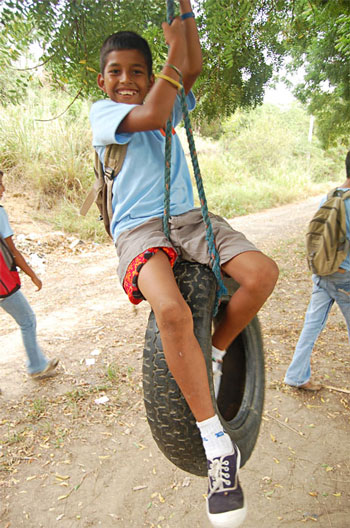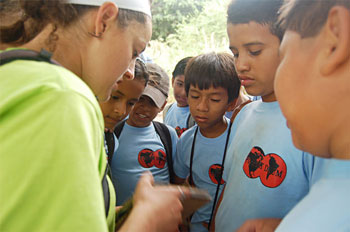Paola’s Report #1
Bioregionalism Education
Summer Session, 2009
May 20 & 22, 2009 – English
(Click here for Spanish/Español)
Photos below
I was greeted with an immediate huddle around me when I arrived for class at the park; the usual “Senorita! Senorita!” followed by a ton of questions about what we will be doing and where will we be going. It’s a bit of a chaotic manner to begin class, but their excitement is electrifying nonetheless.

As I attempted a reasonable approach to listen and mingle with what started as eight but quickly multiplied into 15 different kids, something remarkable was happening. In addition to those who had drawn maps of their neighborhood as homework, kids were eager to show me other things they had made as well. Andreina, who recently joined our class, brought in a banner she made with her sister. It reads: “Your beauty lies in your education and care for the environment, like a tree’s strength lies in its roots.” John Paul, Rody and Francisco, the more rowdy element of our group, interestingly enough had worked together to detail and color the bioregional map that they hadn’t gotten a chance to finish during last week’s class. Selena, always dedicated and sweet, gave me a poem and picture she made about the Earth. And finally, Karen, who most often resists paying attention, handed me a booklet she made for identifying native trees. It was made of leaves and cardboard; a project that the week prior I had only briefly suggested to anyone who was interested. Only our third week and I am impressed with the kids’ growing interest, to say the least.

We started class with a quick overview of what we know about Rio Chone Bioregion/bioregionalism up to this point. Collectively, the kids were able to identify the five main categories of the bioregion and describe a few details about each. Our segment for the day focused on the 10 steps we can take to protect the bioregion. We divided the reading and the kids, either individually or with a partner, spent the next 15 minutes preparing some form of presentation the information to the rest of the class. I walked around and discussed with each kid their topic, taking the opportunity to gain a better understanding of their learning progression so far. After locating the few who lacked motivation, I spent extra time guiding them through it. While the actual presentations were not an absolute success, watching them get ready for them was intriguing. To my surprise, everyone was truly nervous about presenting.
Our best spoken presentation was made by Selena, who compared eating local foods versus buying prepackaged foods; a subject that all the kids proved to be proficient in. They told me that food that is brought to Bahia is not as beneficial as the local fruits and vegetables because it is not as healthy, it requires gasoline consumption to get here and produces more garbage in the end. Jocely and Liset presented with an impressive chart that defined three alternative forms of energy: solar, wind and hydroelectric energy. Rody and Manuel gave a pleasing presentation about modes of transportation. They captivated the kids as they pointed at their illustrations of aerial, marine and terrestrial transportation to explain pollution. It was an admirable redemption from all their commotion throughout the course of the class.

The following evening it was our turn to visit the observation structure at La Cruz, a four-story cement, white cross that stands on the tallest hillside behind the city of Bahia. The walk to get there is a strenuous stairway of no less than 300 steps, but somehow kids managed running the whole way to the top, meanwhile talking, playing and even picking up trash. Once we reached the top of the cross, we could see the whole city and its natural surroundings. The students pointed out the island of mangroves in the middle of the river. And they quickly spotted Ceibo trees on the hillside across the way. They are uniquely attractive native trees with big thorns all the way up the trunk and, at this time of the year, they’ve bloomed beautiful red flowers. As we continued to be awed by the view, we observed frigate birds in the sky, one kayak in the river, fishing boats in the sea, farms in the distance, and spotted some of our homes in the city. Yerson, always an animated story-teller, told us about the day he went fishing with his dad. Instantly everyone else proceeded to share any other kinds of stories they could think of, and soon enough we were back to the unruly sound of 15 voices going all at once. We ended our trip with our usual, and always desperately longed-for, dip in the ocean before parting ways.

– Paola
Translated by Paola Divita




May 20 & 22, 2009 – Spanish/Español
Al llegar al parque los niños me dieron la bienvenida de siempre; gritan “Señorita! Señorita!”y me hacen un montón de preguntas sobre que es lo que vamos a hacer y a donde vamos a ir. Es una manera media caótica de comenzar la clase pero sin embargo el entusiasmo de los niños es electrizante.
Mientras intentaba una manera razonable de escuchar y conversar con los 8 niños que rápidamente se multiplicaban a 15, me di cuenta que algo maravilloso estaba pasando. Además de traer los mapas de sus barrios que se les dio de tarea, algunos niños estaban emocionados por mostrarme otras obras que habían hecho. Andreina, quien recientemente había entrado a nuestra clase, trajo una bandera que pintó con su hermana con un dicho sobre la naturaleza. Curiosamente John Paul, Rody y Francisco, el elemento más escandaloso de la clase, habían detallado y coloreado el mapa bioregional que no avanzaron a terminar durante la clase de la semana pasada. Selena, una niña muy dulce y siempre dedicada, me dio un dibujo con un poema sobre la naturaleza. Y por último, Karen, una alumna que muchas veces se me hace difícil lograr que preste atención, me trajo un librito hecho de cartón y hojas para identificar árboles nativos; algo que la semana pasada yo solamente había sugerido para ver si alguien se motivara. Apenas vamos por nuestra tercera semana de clase y me siento muy impresionada por el interés y el encanto de los niños.
Empezamos la clase con un resumen de lo que ya sabemos sobre el bioregionalismo. Entre todos, los niños pudieron identificar las cinco categorías fundamentales de una bioregión con detalles sobre cada una. La lectura del día se trataba de los diez pasos que podemos tomar para proteger una bioregión. Dividimos las secciones y los niños, individualmente o en pareja, ocuparon los próximos 15 minutos estudiando su tema para dar una presentación al resto de la clase. Observé como se preparaba cada estudiante y tuve la oportunidad de conocerles mejor. Como algunos tenían menos ganas de trabajar, traté de ayudarles un poco más. Aunque las presentaciones no resultaron ser completamente exitosas, fue fascinante ver la emoción y los nervios que sentían los niños al presentarse.
Selena habló sobre los beneficios de comprar comida local versus comida empaquetada, un tema que los niños comprobaron dominar bien. Contaron que la comida que es importada a Bahia no tiene el mismo beneficio que las frutas y verduras de acá porque no es tan nutritiva, usa más gasolina en el transporte y al final produce más basura. Jocely y Liset dibujaron una tabla para definir tres alternativas de generar energía: solar, eólica e hidroeléctrica. Rody y Manuel conversaron sobre la contaminación y conquistaron la atención de todos con sus ilustraciones de transportes aeros, marinos y terrestres; una presentación admirable después de que hayan causado tanta bulla y distracción durante toda la clase.
El próximo día nos tocó ir a La Cruz, una cruz blanca de cuatro pisos, colocada en la loma más alta atrás de la ciudad de Bahía. Para llegar hay que subir casi 300 gradas y mientras los niños iban corriendo hasta el tope, también iban conversando, jugando y hasta recogiendo basura. Desde arriba podíamos ver toda la ciudad y la naturaleza de alrededor. Los niños señalaron a la isla de manglares en la mitad del río. Enseguida se dieron cuenta de los Ceibos del otro lado de la loma, que justo en esta época lucen de flores rojas. En el paisaje también observamos fragatas en el cielo, un kayak en el río, los botes de los pescadores en el mar, fincas en las lomas y nuestras casas en la ciudad. Yerson como siempre, contando historias, nos contó sobre un día que acompañó a su papá a pescar. Casi instantáneamente todos se animaron por contar sus historias también y otra vez más regresó el penoso ruido de 15 voces platicando a la misma vez. Como de costumbre los niños suplicaron que fuésemos a la playa antes que se termine nuestro paseo; jugamos un rato más y nos despedimos.
-Paola

Your article helped me a lot, is there any more related content? Thanks!
I don’t think the title of your article matches the content lol. Just kidding, mainly because I had some doubts after reading the article.
Can you be more specific about the content of your article? After reading it, I still have some doubts. Hope you can help me.
Thanks for sharing. I read many of your blog posts, cool, your blog is very good.
Your point of view caught my eye and was very interesting. Thanks. I have a question for you.